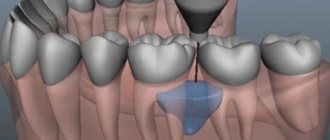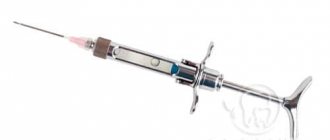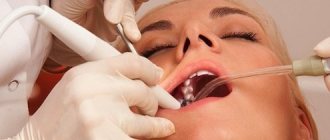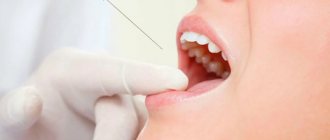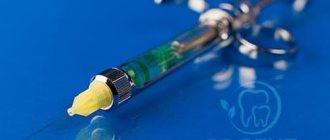With the advent of new, more effective anesthetics, it became possible to use a new method of pain relief - intraligamentary anesthesia. With intraligamentary (intraperiodontal, intraligamentous) injection, rapid anesthesia occurs. The difference between this type of anesthesia and others is the introduction of a small amount of anesthetic solution (0.1-0.3 ml) under high pressure into the periodontal gap. To perform this anesthesia well, you need special injection equipment, a standard strong anesthetic, and special needles.
Injection equipment should provide dosed (0.1;0.2 ml) and slow (over 20-25 s) injection of an anesthetic solution under pressure into the periodontal tissue surrounding the tooth. 1. A standard carpule syringe is designed for conducting conduction and infiltration anesthesia and cannot always provide high-quality injection of an anesthetic solution into the periodontium. 2. Special injectors (create high pressure in periodontal tissues when administering the drug): CITOJECT injector, etc. They are made in the shape of a fountain pen, have a dispenser, with each movement of the piston, 0.06 ml of anesthetic solution is injected under very high pressure. The disadvantage of the injector design is the small dose of anesthetic (0.06 ml), which is injected into the tissue once. For high-quality pain relief, you need to make several injections. Repeated injections injure the periodontium and cause post-injection pain (16% of patients). SOFTJECT injector with dosing wheel. It has the shape of a fountain pen. The injection solution is injected into the periodontium by rotating the wheel. This ensures gradual saturation of periodontal tissue with the required amount of anesthetic (on average 0.2 ml) and significantly reduces the number of post-injection complications. Injector FALCON, etc. Available in the form of a pistol. By pressing the lever (trigger) of the injector, 0.2 ml of anesthetic is injected under pressure. One injection is sufficient for intraligamentary anesthesia. The effectiveness of pain relief depends on the manual skills and ability of the doctor: by pressing the injector lever, administer a dosed injection of anesthetic into the periodontium; The harder you press the lever, the greater the pressure of the solution on the tissue. When performing an injection, it is very important to be able to feel and adjust this pressure using a lever, so that an average of 0.2 ml of anesthetic is slowly introduced into the periodontium over 20-25 seconds, without damaging the periodontal tissue surrounding the tooth. It should be noted that the shape of the injector is very convenient for anesthesia, especially on the lingual side of the body of the lower jaw. The injector kit includes: - two removable tips for various types of carpule needles (European and American systems); — a protective cylinder for the carpule (made of plastic), it is put on the carpule before injection to prevent injury to the patient from glass fragments in case of possible rupture of the carpule during injection.
Selection of anesthetic 1. For intraligamentary anesthesia, a strong standard anesthetic based on 4% articaine hydrochloride with adrenaline 1:100,000 (Ultracain DS Forte) is needed. 2. In patients at risk, a similar anesthetic with a lower concentration of adrenaline 1:200,000 (Ultracain DS) is used, which provides effective but less durable pain relief. 3. Anesthetics without adrenaline do not provide 100% pain relief. Selection of carpules For intraligamentary anesthesia, glass carpules of increased strength are used (production). High quality glass and optimal piston length ensure the integrity of the carpule during injection under high pressure. Carpule needles For intraligamentary anesthesia, special polished needles with a metal cannula are used, created specifically for intraligamentary anesthesia. These needles have a diameter of 0.3 mm and a length of 8, 10, 12 mm (shorter needles are used in the area of the front teeth, longer ones are used for anesthetizing molars). It is not recommended to use needles 16 mm long: a long needle bends when inserted into the periodontium, it cannot penetrate the tissue and provide a high-quality injection.
Local anesthesia in dentistry: types and preparations
In dentistry, both therapeutic and surgical, different types and techniques of anesthesia are used, for example, conduction, infiltration, intracanal, intraosseous, intraligamentary (intraligamentous), tuberal and others. Their differences lie in the place of application and in some features of their effects. As a rule, modern dental clinics in Moscow use carpule anesthesia. This means that the anesthetic is supplied in disposable carpules - a kind of cartridges with an anesthetic solution that are inserted into syringes with screw-on disposable needles. Due to this, the carpules remain sterile, since the dentist does not have to open them, thereby eliminating contact of the medicine with air.
Conduction anesthesia
Conduction anesthesia is aimed at blocking the nerve through which the pain signal is transmitted. In this way, it is possible to “turn off” a significant area of the jaw associated with the nerve that was exposed to the drug for a fairly long time - from an hour to an hour and a half. As a rule, conduction anesthesia is prescribed if extensive intervention is required on several molars and adjacent soft tissues. With the conduction method, the anesthetic is administered in close proximity to the nerve, and it is very important to correctly calculate this location, since if it is too far from the nerve, pain relief may not occur, and if it gets into the nerve itself, a complication such as neuropathy may develop . According to statistics, neuropathy occurs in 1% of cases and most often completely recedes within a year. By the way, when conducting conduction anesthesia in dentistry under ultrasound guidance, its safety and effectiveness are significantly increased.
Topical anesthesia in dentistry and drugs
Infiltration or application anesthesia in dentistry is carried out by soaking soft tissues with an anesthetic solution, as a result of which the nerve endings located in the treated area are blocked. With topical anesthesia, the anesthetic is applied without the use of a syringe. Using a cotton swab or your fingers, apply a small amount of the product, which subsequently penetrates approximately 3 mm inside and numbs the selected area. In dentistry, it is used to perform simple and quick operations associated with anesthesia of the oral mucosa, since it lasts, on average, from 10 to (in rare cases) 25 minutes. It is often preceded by subsequent injection anesthesia, especially if the patient is a child or is afraid of injections. There are also preparations for topical anesthesia in the form of aerosols. They are not widely used in dentistry due to difficulties in calculating dosage, as well as easy penetration into the respiratory tract and bloodstream, which increases the risk of complications.
Features and mechanism of action
The specific features of the method can be considered:
- record short latency period - the composition begins to act almost immediately after administration;
- the anesthetic threshold is quite high and remains uniform throughout the entire period of anesthesia;
- the drug administration procedure is not associated with physical pain;
- the soft tissues of the cheeks, tongue, lips are not subject to general numbness either at the time of administration of the composition or during its action;
- does not provoke the formation of hematomas, reflex post-surgical chewing of numb areas of the mucous membrane and fragments of the oral cavity;
- makes it possible to carry out corrective manipulations to eliminate malocclusion defects after therapeutic procedures much easier, more convenient and faster than with standard anesthesia;
- the toxic effect on the body of the drug itself is extremely minimal , since the volume of its use is negligible.
The principle of action of the anesthetic is as follows. The product is injected into the dental periodontal ligament.
This ensures its targeted effect on a specific unit of the jaw row, while maintaining the functionality and natural state of the surrounding tissue fragments.
An intraosseous anesthesia effect is created, which makes it possible to eliminate many dental diagnoses absolutely painlessly.
Infiltration anesthesia
This is one of the most common methods of anesthesia in modern dentistry. There are two types of infiltration anesthesia: direct and indirect. Direct anesthesia is injected directly under the mucous membrane near the teeth that require treatment, and acts at the injection site. Indirect spreads to surrounding tissues and covers a larger area, while its prevalence depends on the type of surrounding tissues. For example, on the upper jaw the alveolar process is more porous, while on the lower jaw it is denser, which means that the effect of infiltration anesthesia on the upper jaw will be more effective.
Key Aspects
The number of injections required is determined by the number of root shoots. In this case , more than two injections are not carried out at the same time . On average, the content of the drug in one dose varies from 0.2 to 0.5 ml.
According to the medical protocol, it takes the doctor up to 15 seconds to fully administer the drug. Failure to comply with this rule can lead to complications and reduced effectiveness of the product.
If for some reason there is no fluid flow, the syringe should be replaced with a new one, otherwise the composition may linger in the subcutaneous layer of soft tissue and provoke the development of a hematoma.
Intraligamentary anesthesia
Intraligamentary anesthesia is also called intraligamentous and intraperiodontal. Its difference is in higher pressure when administering an anesthetic, which ensures uniform spreading of a small amount of the drug in the periodontal space, as well as its penetration into the intraosseous space. Drugs should be administered very slowly. When using this type of anesthesia, significantly less drug is required than with conventional infiltration; it occurs within 15-45 seconds and lasts for 20-30 minutes. For intraligamentary anesthesia, special syringes are often used, which make it possible to administer the drug under the required pressure without unnecessary effort and thus achieve the best result.
Possible complications
Complications cannot be excluded during the manipulation:
- accidental injury or damage to the dental ligament with the tip of a needle caused by increased pressure at the time of injection of the composition;
- rupture of mucous tissue;
- pain in the first 24 hours with mechanical impact on the problem area - this happens if the injection is given faster than the protocol requires;
- local necrotic manifestations of the surrounding tissues - occurs when the angle of inclination during the administration of the product is violated.
Intraosseous anesthesia
Intraosseous anesthesia in dentistry is chosen when infiltration or conduction anesthesia is ineffective. It is usually performed in the area of the lower molars and is indicated for treatment, tooth extraction and operations on the alveolar process. However, it is rarely used due to the complex technique of execution: it is necessary to dissect the mucous membrane, then make a hole in the bone with a special bur with a diameter equal to the size of the syringe needle in order to direct the syringe directly to the spongy substance. The drug should be administered slowly, under high pressure.
Among the advantages of this type of anesthesia is significant efficiency; a small amount of even a weak anesthetic is sufficient. Among the disadvantages are the complexity of implementation, as well as serious risks of complications if the drug enters the bloodstream, which is likely due to accidental damage to a vessel.
Indications and contraindications
The intraligamentary anesthesia technique can be performed in the following clinical cases:
- to eliminate pain during treatment or removal of an affected tooth;
- if there is a need to administer a reduced dose of the drug, this is necessary if the patient is prone to allergic manifestations or intolerance to certain groups of analgesics;
- when the conduction and infiltration methods of pain relief are insufficiently effective.
At the same time, there are often cases when the use of the technique is not only not justified, but also dangerous:
- periodontitis of a marginal type organ;
- with clinically incomplete formation of the root system of fragments of the jaw row;
- during surgical manipulations in the area of the root apex;
- during long-term medical actions lasting more than minutes;
- endocarditis in the acute stage;
- congenital cardiac diagnoses;
- operations on the cardiovascular system.
Intracanal anesthesia
The intracanal method of pain relief speaks for itself. Typically, intracanal anesthesia in dentistry is carried out in this way: using a drill, a hole is made in the tooth corresponding to the diameter of the needle, and the drug is injected directly into the pulp or deeper into the canal. Sometimes the carious cavity itself is used for this. If we are talking about the intraligamentary technique, then we mean the introduction of a local anesthetic solution into the space at the root of the tooth (periodontal), and the tuberal technique means the introduction of a substance into the posterior alveolar branches of the upper jaw.
Reviews
Despite the fact that intraligamentary anesthesia is a technique whose use in domestic clinics began relatively recently, it has already managed to acquire both its supporters and ardent opponents.
If you have encountered this type of pain relief in your own practice, you can leave your comment in the appropriate section. Your experience may be useful to someone.
If you find an error, please select a piece of text and press Ctrl+Enter.
Tags intraligamentary anesthesia treatment
Did you like the article? stay tuned
Previous article
Learn in detail about all the nuances of dental treatment under a microscope
Next article
Basics of electrophoresis for teeth
Tuberal anesthesia
Tuberal anesthesia is so named in connection with the injection site - the tubercles of the upper jaw, which are called tuber in Latin. The posterior alveolar nerves are located here, innervating the area of the alveolar ridge from the third to the first molar. This type of anesthesia is the most dangerous in terms of possible complications due to individual differences in the structure of this area and the location of nerves and blood vessels in it. There are intraoral and extraoral methods of administering tuberal anesthesia. It is believed that the intraoral method is more likely to cause injury, while the external method is safer and it is also easier to ensure adequate antiseptic treatment of the surface before injection.
Computer anesthesia
Computer anesthesia allows dentists to calculate more accurate doses of the drug, administer it at the desired speed, pre-selected by the computer, and painlessly guide the syringe needle, which has a special cutting edge. Anesthesia administered with high precision can last longer - up to 40 minutes, and visual and audio signals provided by the device allow the doctor to position the needle as needed, without the risk of tissue damage, introducing anesthetic into the bloodstream or placing the needle too far from the nerve.
Ultrasound anesthesia
When performing anesthesia, it is very important to choose the right injection site, since a mistake can lead to serious complications. This is especially true for conduction anesthesia, where the drug must be in close proximity to the nerve, but the needle cannot touch it. Ultrasound successfully helps determine the site of anesthetic injection. Under the control of an ultrasound machine, it is possible to calculate down to the millimeter the location of the needle and its proximity to the nerve, thereby ensuring the most effective and safe anesthesia of the desired area.
Administration technique
The introduction procedure is carried out step by step according to the following algorithm:
- the entire external surface of the working area is thoroughly cleaned of plaque and rocky deposits;
- treating teeth with antiseptic agents;
- after this, strictly parallel to the tooth, the doctor inserts the needle until the periosteum is felt, but not more than 3 mm;
- Having reached the desired depth, slowly introduces the composition;
- the number of injections is determined by the number of roots and the complexity of their structure.
The effect occurs almost instantly. The most effective drugs in this regard are:
- Trimecaine;
- Ultracaine;
- Lidocaine and their derivatives.
The injection is made only with syringes specially designed for this purpose. They are subject to certain requirements:
- providing the necessary pressure force in the process of supplying the composition to the tooth tissue;
- there is a limitation on the volume of the introduced component . The maximum permissible dose is 0.6 ml of the product;
- the tips included in the injection kit must have several angles of inclination. At the time of the injection, the doctor injects the solution at an angle of 30 degrees.
After the medicine reaches its target, the needle is held in its original position for some time, and only after a few seconds is it removed. This is necessary for complete absorption of the anesthetic.
General anesthesia in dentistry
In some cases, the patient may require dental treatment under general anesthesia. As a rule, it is used when serious and long-term treatment is necessary, for example, the removal of several teeth at a time or complex operations on the jaw. An indication for the use of general anesthesia in dentistry may also be serious dental phobia or a disease in which a person cannot adequately communicate with the doctor, or he may have unexpected reactions to the doctor’s actions, as, for example, with epilepsy.
As an alternative to general anesthesia to correct mood and relieve fear of dental treatment, there is sedation in dentistry. It does not “turn off” consciousness, but puts you into half-asleep and calms you down, helps you relax, and perceive what is happening in a positive way. However, sedation is not anesthesia, so it is used in combination with local anesthesia.
When is anesthesia used in pediatric dentistry?
Most adults have a fear of dental treatment left over from childhood, so today one of the tasks of a pediatric dentist is to prevent the occurrence of dental phobia or get rid of fears that have already formed in the child. General anesthesia is often the only way to solve dental problems in children under three years of age, as well as in children with developmental disabilities, in particular with autism, Down syndrome, cerebral palsy or epilepsy.
It is not always necessary to carry out dental treatment in children under anesthesia. A small patient who comes to a kind and open doctor will be able to perform most of the manipulations while conscious. The main condition is that these manipulations must be painless. According to some studies, today the most painful procedure for a child is the anesthetic injection itself. That is why in pediatric dentistry, before an injection, topical anesthesia is used, the preparations for which have a pleasant taste, which contributes to a good mood in children and their cooperation with the doctor.
In addition, today in dentistry it is no longer uncommon to have a device for computer anesthesia, which allows painless administration of medicine and clearly measuring its correct dosage.
Modern anesthesia in dentistry: contraindications for use
The main contraindication to anesthesia in dentistry is an allergy to its components; side effects should also be taken into account, which are most often associated with the presence of additional substances in the anesthetic solution: vasoconstrictors, preservatives and stabilizers. In particular, it is necessary to especially carefully select drugs for patients with cardiovascular diseases, arterial hypertension, and decompensated forms of endocrine diseases (diabetes mellitus, thyrotoxicosis, and others). To determine which substances a person has a negative reaction to, the doctor sends him to the Institute of Allergology to perform tests. In accordance with these data, a safe drug for local anesthesia is selected, and in case of reaction to all groups of anesthetics, general anesthesia is used.
Preparation for the procedure
Before using this technique, you should undergo an allergy test. This is especially necessary in cases:
- tendency to intolerance to drug components;
- in the presence of bronchial asthma , runny nose of allergic origin, atopic manifestations of dermatitis;
- the patient has been diagnosed with angioedema or anaphylactic shock at least once;
- in cases where such a procedure is performed for the first time.
The test is carried out as follows. The composition is brought to an extremely low concentration using saline and injected under the skin not too deep into the wrist area.
The following is the evaluation algorithm:
- the allergy appeared almost instantly - a contraindication for use;
- reaction after 15 – 20 minutes – the use of the product is extremely undesirable;
- the outer surface of the wrist has not changed - the composition can be used. The body test for anesthetic is negative.
What are the features of anesthesia in dentistry for pregnant women?
It is also important for pregnant women to ensure pain-free dental treatment. However, conventional painkillers are not suitable for them, since vasoconstrictors (also known as vasoconstrictors) are usually added to the anesthetic solution in order to keep it in the right place and prolong its effect. Vasoconstrictors also reduce potential common side effects and reduce bleeding. For example, adrenaline added to a four percent solution of articaine can extend its analgesic effect from three to forty-five minutes.
Only mepivacaine can be used without adrenaline, since, unlike other drugs for local anesthesia used in dentistry (articaine, which is considered the best option today, novocaine and lidocaine), it does not have the ability to dilate blood vessels at the injection site, which means it can be recommended for pregnant women, children, and other categories of patients who should not be administered adrenaline. These include, for example, those suffering from cardiovascular diseases, arterial hypertension, severe forms of diabetes mellitus, and severe thyrotoxicosis.

